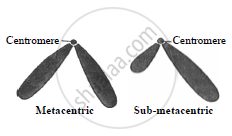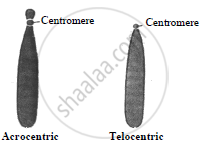Advertisements
Advertisements
प्रश्न
Explain the types of chromosomes on the basis of position of centromere.
उत्तर
Chromosomes can be classified into four types on the basis of position of centromere:
a. Metacentric:
Centromere is in the middle of the chromosome and hence, the two arms are nearly equal.
Chromosome looks ‘V’-shaped in anaphase.
b. Submetacentric:
Centromere is not in the center but some distance away from the centre of
chromosomes and therefore arms are unequal in length.
The chromosome appears ‘L’ shaped in anaphase.
c. Acrocentric:
Centromere is near one end of the chromosome. One arm is very short, while other is long.
d. Telocentric:
Centromere is at the extreme tip of the chromosome.
The arm is only on one side.
Chromosome remains rod shaped even in anaphase.
Chromosome appears ‘i’ shaped.


APPEARS IN
संबंधित प्रश्न
Briefly mention the contribution of T.H. Morgan in genetics.
Describe the structure of sex-chromosomes.
Choose the correct options of the following question:
Study the given monohybrid cross:

A test cross for this Fj will be:
A B B C C D E F G H I
From the above figure identify the type of mutation and explain it.
From the following identify the INCORRECT statement/s with respect to the chromosomes.
i. Chromosomes are capable of self replication and play vital role in heredity, mutation, variation, and evolutionary development of eukaryotic species.
ii. Chromosomes are visible during cell division.
iii. Chemically eukaryotic chromosomes are made of mRNA, histone and non-histone proteins.
iv. The number of chromosomes varies within the population of a particular species.
Extra nuclear chromosomes occur in ______.
Mendel’s work was rediscovered by three scientists in the year ______.
Which of the following statements indicates parallelism in genes and chromosomes?
- They occur in pairs.
- They segregate during gamete formation.
- They show linkage.
- Independent pairs segregate independently.
During mitosis, chromosomes distribution to the daughter cell is ______.
What do you mean by locus?
